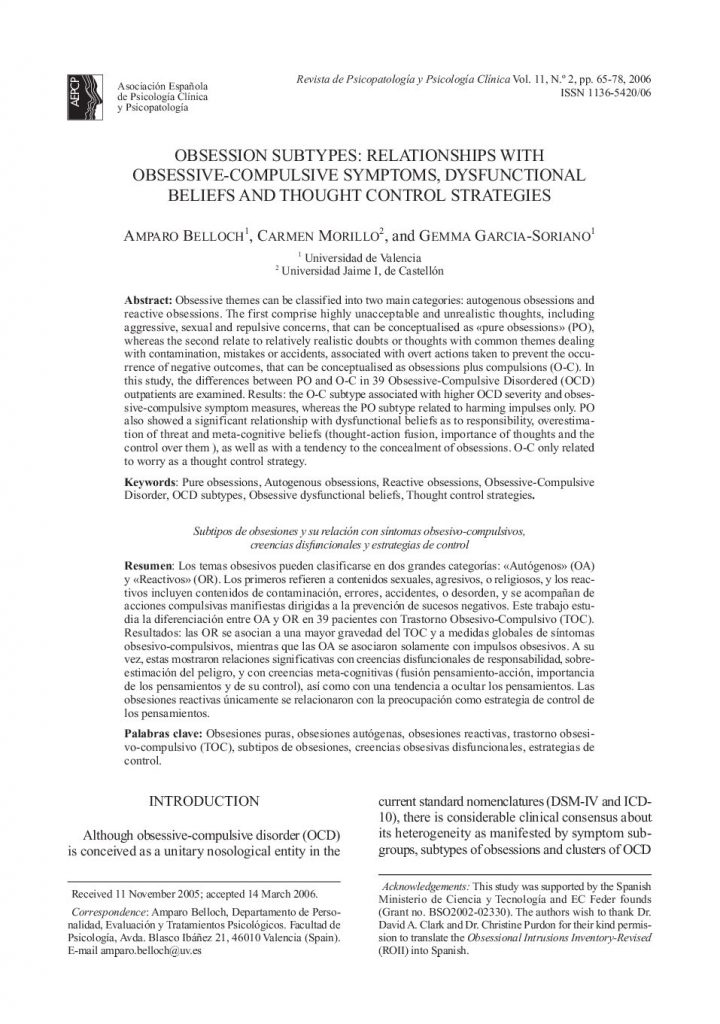Subtipos de obsesiones y su relación con síntomas obsesivo-compulsivos, creencias disfuncionales y estrategias de control.

- Subtipos de obsesiones y su relación con síntomas obsesivo-compulsivos, creencias disfuncionales y estrategias de control.
- Estado emocional y conducta de enfermedad en pacientes con VIH/SIDA y enfermos oncoló-gicos.
- Estilo atributivo negativo, sucesos vitales y sintomatología depresiva.
- Intervención psicológica en un caso de evitación interoceptiva en el deporte.
- Propuesta de especificadores diagnósticos vinculados al estrés y el trauma: una aportación a la nosología psicopatológica.
- Cartas al Director.
Obsessive themes can be classified into two main categories: autogenous obsessions and reactive obsessions. The first comprise highly unacceptable and unrealistic thoughts, including aggressive, sexual and repulsive concerns, that can be conceptualised as “pure obsessions” (PO), whereas the second relate to relatively realistic doubts or thoughts with common themes dealing with contamina-tion, mistakes or accidents, associated with overt actions taken to prevent the occurrence of negative outcomes, that can be conceptualised as obsessions plus compulsions (O-C). In this study, the differ-ences between PO and O-C in 39 Obsessive-Compulsive Disordered (OCD) outpatients are exam-ined. Results: the O-C subtype associated with higher OCD severity and obsessive-compulsive symp-tom measures, whereas the PO subtype related to harming impulses only. PO also showed a signifi-cant relationship with dysfunctional beliefs as to responsibility, overestimation of threat and meta-cognitive beliefs (thought-action fusion, importance of thoughts and the control over them), as well as with a tendency to the concealment of obsessions. O-C only related to worry as a thought control strategy.
Los temas obsesivos pueden clasificarse en dos grandes categorías: “Autógenos“ (OA) y “Reactivos” (OR). Los primeros refieren a contenidos sexuales, agresivos, o religiosos, y los reactivos incluyen contenidos de contaminación, errores, accidentes, o desorden, y se acompañan de acciones com-pulsivas manifiestas dirigidas a la prevención de sucesos negativos. Este trabajo estudia la diferen-ciación entre OA y OR en 39 pacientes con Trastorno Obsesivo-Compulsivo (TOC). Resultados: las OR se asocian a una mayor gravedad del TOC y a medidas globales de síntomas obsesivo-compulsivos, mientras que las OA se asociaron solamente con impulsos obsesivos. A su vez, estas mostraron relaciones significativas con creencias disfuncionales de responsabilidad, sobreestimación del peligro, y con creencias meta-cognitivas (fusión pensamiento-acción, importancia de los pensa-mientos y de su control), así como con una tendencia a ocultar los pensamientos. Las obsesiones reactivas únicamente se relacionaron con la preocupación como estrategia de control de los pensa-mientos.



